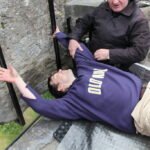Rope Bridge in Carrick-a-Rede | Everything You Need to Know
We all have those friends who just cannot stay in one place, right? They are never at rest, always waiting for the next adventure. Being mere tourists does not satisfy them; they want something adventurous, challenging, and a little bit dangerous during trips. For these lovers of adventure, the rope bridge is the destination. It can certainly be a difficult thing to cross a 100-foot-high bridge over the ocean when the wind picks up, swaying the bridge in the process.
Hello, Today, I will discuss the basic knowledge of the Rope Bridge, including ticket prices and nearby attractions. So now, let the game begin!
Where is the Rope Bridge?
The Rope Bridge is located in Northern Ireland, just a stone’s throw from Ballintoy Harbour. It is easy to reach—only a 10-minute drive from Ballycastle or a 20-minute drive from the Giant’s Causeway.
In summer, it may take a bit longer due to the large number of tourists. It’s not surprising, considering that the two most visited tourist attractions in Northern Ireland include the Giant’s Causeway and the Rope Bridge.
This road also has several tour buses coming and going. It’s easy to connect a day tour with Dublin or Belfast or to use public transport. The quickest route from Dublin to the Rope Bridge is by train, which takes approximately 5 hours and 48 minutes and costs between €40 to €65. Alternatively, you can take a bus, which takes a similar amount of time.
It is also possible to rent a car. If you intend to do so, remember that Irish country roads are quite narrow and hilly compared to U.S. country roads, and people drive on the opposite side. So, unless you’re a seasoned driver, you may prefer a day tour or public transport.
What Time to Visit the Rope Bridge?
Spring or summer (May to September) is the best time to visit the Rope Bridge, as the weather is more suitable for outdoor activities. The bridge is also open longer during this period, from 9:00 am to 5:00 pm, giving you more time to enjoy. However, summer tends to be crowded, so consider visiting on weekdays or early in the morning.
I went in May, as it’s less rainy and windy during that time. By the way, the Rope Bridge closes immediately when the winds are too high, so make sure to pick the right season! We don’t want any surprise closures to ruin our plans.
Is the Rope Bridge Free?
No, it’s not free—but it’s not too expensive either. Typically, adult tickets cost £13.50, child tickets £6.75, and family tickets £33.75. Prices vary by season. Below are the peak season prices at the time of writing:
- Adult: £15.50
- Child: £7.75
- Family: £38.75
Here’s a twist: you only pay if you want to cross the bridge. A walk to the actual bridge is free and enjoyable—it’s about a 20-minute (1 km) walk from the Rope Bridge car park.
When you arrive, you’ll see a wooden hut near the car park. It might seem like you need to pay to go past it, but you don’t—unless you plan to walk across the bridge. Just walk past it and continue.
Many people did this because they were afraid of heights. They parked and paid £10 per car, then simply enjoyed the beauty of the area. The walk to the bridge is scenic. You’ll also see Larrybane Quarry, Sheep Island, and possibly even Scotland on a clear day.
Locals recommend allowing 1 to 1.5 hours for the visit. If it’s not busy, you can finish faster, but during summer, it may take longer.
I spent about 2 hours there, taking my time and enjoying everything. I’d recommend you do the same. Just go with the flow and have fun!
Is the Rope Bridge Safe?
Okay fine, I’ll tell you my experience—that’ll give you a clear idea.
Like anyone, I was excited to cross the bridge. Near the parking lot was a small shop selling drinks and snacks with outdoor seating. I didn’t stop though—I was eager to reach the bridge.
Fifteen minutes later, I arrived and saw a line of people waiting. You’ll likely see the same—this bridge is always busy! I only waited 15 minutes, and there was plenty to observe while waiting.
What caught my eye was the height. Seeing it in real life, I saw wires hanging 100 feet in the air! I thought if I fell, I’d surely die. This “death trap” stretched 60 feet from Northern Ireland’s mainland to the fishing island of Carrick-a-Rede.
The nerves kicked in. I saw some people back out, but why not take the chance after coming so far?
Eventually, I calmed myself. The safety measures helped. Staff members on both ends monitored the number of people on the bridge at one time. The planks were close together, and the staff assured us it would only take 20–30 seconds to cross.
As I waited, I learned a few things:
- If you’re visiting multiple National Trust sites (e.g., Giant’s Causeway, Downhill Demesne, Castle Ward), an annual membership can be cost-effective.
- If wind conditions are unsafe, they close the bridge—but the coffee shop remains open.
- You can stay nearby! Carrick-a-Rede cottage is a lovely spot, perfect for stargazing and exploring Ballintoy village, local pubs, and the beach.
Why Was the Bridge Built?
It all began long ago when fishermen used Carrick-a-Rede as the best place to catch salmon. The name comes from Scottish Gaelic “Carraig-a-Rade,” meaning “The Rock in the Road”—a reference to the island blocking migrating salmon.
Carrick-a-Rede and Larrybane have been salmon fishing spots since 1620. Though the fishing has stopped, it was once a big deal along the Causeway Coast. They even built a castle along the River Bann to regulate fishing.
King James I & VI offered salmon fishing rights in the 17th century to Protestant traders from London to entice them to Ireland. You’ll still see small fishing cottages along the coast—some on islands like Carrick-a-Rede and Kinbane Head.
Salmon Story
According to legend, a salmon gave great knowledge to Finn McCool after he accidentally ate it. There’s even a sculpture of this “Big Fish” in Belfast, created in the 1970s to mark the return of salmon to the River Lagan.
Fishermen have built bridges to the island for over 350 years. In the 1970s, it was just a single handrail and some wooden planks. There’s even a photo of a brave man calmly sitting on the rickety bridge!
Today, it’s much safer—with two handrails, a sturdy boardwalk, and side nets. The current rope bridge was installed in 2008 by a Belfast-based firm and is secure for all.
What Happened to the Fishing?
It all ended in 2002 when fish migrated elsewhere. Overfishing and pollution also caused salmon numbers to drop. Alex Colgan from Ballintoy was the last person to fish at Carrick-a-Rede. Now, only a whitewashed cottage remains.
What’s on the Other Side of the Bridge?
Brave the 100-foot-high swaying bridge and you’ll be greeted with stunning views of green waters—perfect for selfies and breathtaking moments.
When I crossed, I was surprised by the panoramas of Rathlin Island and even Scotland. It’s close to the UNESCO World Heritage Site, the Giant’s Causeway. Seabirds fill the skies. If you’re lucky, you may spot basking sharks, dolphins, or porpoises.
Many people bring picnics to enjoy the view. It’s a great idea—I’ll do that next time.
Also, don’t miss stargazing! Carrick-a-Rede is one of only two sites in Northern Ireland awarded Dark Sky Discovery status (the other is Lough Neagh’s Oxford Island). The night skies here are magical.
Even if you can’t stay overnight, take a few hours to soak in the surroundings before crossing back over the bridge.
After crossing, you can take stairs up another path that gives you a final view of the bridge before returning to the main trail and car park.
On the Way Back
After my crossing, I felt happy and satisfied. I remembered the spectacular scenery and the thrill of the bridge. Though I was sad to leave, I was grateful for the experience.
Before You Go: What Do You Need?
- Book a ticket. Timed tickets are now required and available online. Add 15–20 minutes to your schedule for the walk from the car park to the bridge.
- Parking charges apply. If you’re paying to cross, parking is included. Otherwise, parking costs £10.
- Consider an annual membership if visiting more than two National Trust sites.
- Explore the area! Whitepark Bay (8-minute drive), Dunseverick Castle (5 minutes), Kinbane Castle ruins (a bit harder to access), Ballintoy Harbour (7 minutes), Ballycastle Beach (6 minutes), Giant’s Causeway (20 minutes), Dunluce Castle (21 minutes), Bushmills Distillery (18 minutes), The Dark Hedges (19 minutes).
- Dress appropriately. The area is open and often windy—even in summer. Bring warm, waterproof clothing if needed.
- Bring your camera—but move quickly! Staff may ask you to move along while taking photos.
That’s the Rope Bridge! If you’re visiting the Causeway Coastal Route, don’t forget to include it. It’s now much safer and one of the most beautiful spots in all of Ireland.




